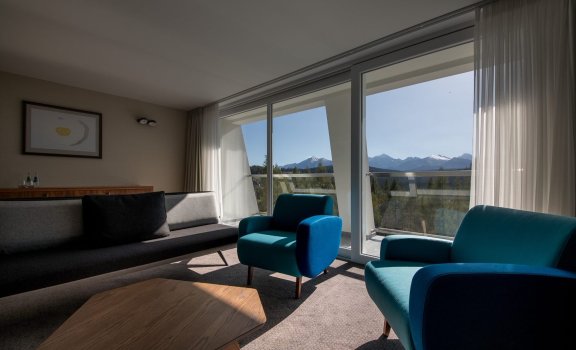The 50s. Family skiing

Bukowina Tatrzańska is a cradle of family skiing.The first ski lifts were constructed here, including drag lifts. They were not too long. Families with children felt safe here and successfully learned the ABC of skiing.
The 60s. The first designs of "Harnaś"

Based on a decision of the Central Labour Cooperative Union, the first drawings of the Harnaś Recreation Centre were created. There were three versions of the design. “Harnaś” was constructed in the years 1966-1969 on the Buńdowy Wierch hill. This was a modernistic building designed by Leszek Filar, Przemysław Gawor and Jerzy Pilitowski.
The 70s. "Harnaś" blended in with nature

The hotel was set diagonally to blend it in with the landscape of Podhale and protect it against winds without overwhelming the surrounding buildings. All rooms in “Harnaś” had windows on the sunniest side and a beautiful panorama of the Tatras.
“Harnaś” competed with hotels in Zakopane. It offered services that were greatly appreciated by guests: double rooms with a bathroom, a dining room with a kitchen, a bar, service staff and scarce products at that time, like beer, ham and sweets.
The 80s. Summer in "Harnaś"

“Harnaś” was full all year round. In the summer, it guaranteed the proximity of the mountains and Morskie Oko Lake, a view of the southern side of mountain ridges, and very sunny slopes with excellent conditions for sunbathing and hiking.
The bus at that time travelled from Zakopane to Morskie Oko Lake via Bukowina. From the bus, tourists could admire beautiful views. Thus, the “Ogórek” (cucumber-like) bus was created on the basis of a Skoda by PKS employees, who decided to improve the aesthetic impressions of tourists by producing an open-deck bus with a stretched tarpaulin roof.
2016 Bukovina acquires "Harnaś"

BUKOVINA becomes the new owner of the building and transforms it into Harnaś Hotel. With respect to the modernistic topography and the work of designers of the day, the original logotype has been preserved. The inspiration was a signboard fixed on the roof of the building. It was digitalised and then individual letters were optically corrected.
























